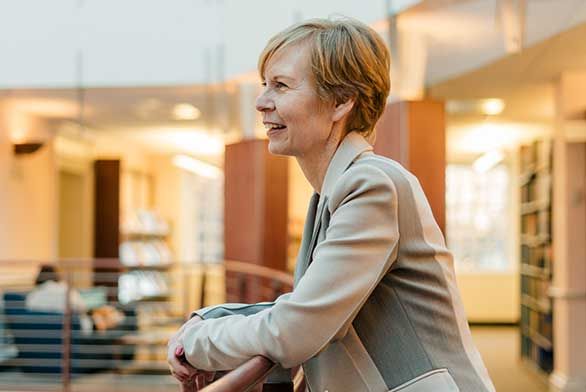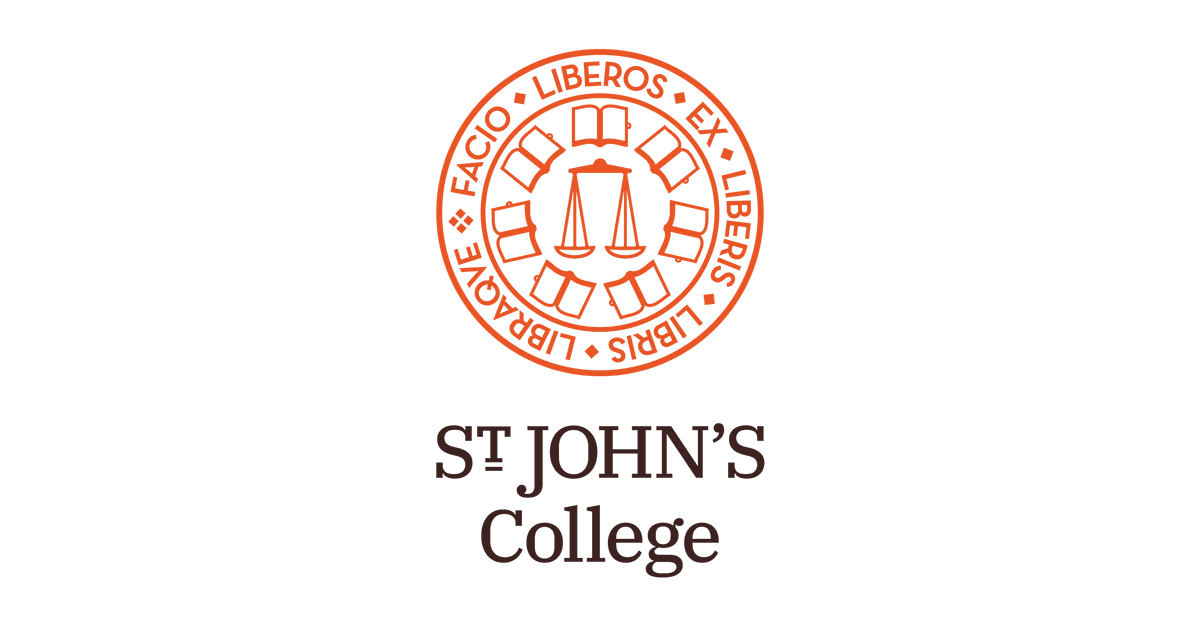Collegewide President Nora Demleitner on Preserving the Program While Preparing for the Future
August 16, 2024 | By Kirstin Fawcett (AGI26)
Nora Demleitner, like most people connected with St. John’s College, is a fan of asking big questions. Assuming the role of collegewide president in July 2024, she posed a substantial one after serving for more than two years as Annapolis campus president: “How can we ensure the Program remains strong while accommodating today’s students, all while preparing them for meaningful lives and careers in a rapidly changing world?” This inquiry has no simple answer—but that, of course, has not stopped Demleitner (whose own favorite Program book is Democracy in America) from tackling it head-on, whether from her Mellon Hall office in Annapolis or an airplane high above the American Southwest.

Demleitner’s expanded responsibilities as collegewide president will include regular visits to New Mexico, where she looks forward to learning more about St. John’s role in the region’s educational ecosystem and familiarizing herself with the campus’ student body, staff, and faculty. “We really need to think carefully about having distinctive campuses under a collegewide structure,” Demleitner says. “What should we hold on to, and what should we build on? How can we take advantage of both locations? How can we have the freedom to rethink and review? Changing from campus to collegewide president will give me the opportunity to do that.”
Keeping the Program strong, Demleitner notes, involves recognizing that it is the uniting factor between two campuses with their own cultures and histories. It also requires looking beyond the reading list: as collegewide president, she plans on meeting incoming students in Annapolis and getting to know students in Santa Fe while evaluating how the college can best set up these diverse groups up for success. “We’ve been much more responsive to wellness needs,” Demleitner says. “And we’re trying to ensure with an increasingly diverse student body that everyone feels like they can be themselves and belong and thrive on our campuses.”
St. John’s currently offers the Pritzker Bridge Program, a late-summer orientation for first-year students including Pell Grant recipients, first-generation college students, international students, students of color, and any student who requests additional connections to resources and social supports as they transition into St John’s. Recognizing an ongoing need for extra student support, the college recently received $350,000 from the Endeavor Foundation for enhanced mental health and wellness offerings. These funds are being used for crisis intervention services, staff training in the Student Health & Wellness Center, expansion of outdoor programming, and exploring the link between campus belonging and mental health and wellness.
St. John’s wants its students to embark on successful journeys as students and—following graduation—entry-level job seekers. Amid a competitive economy and the rise of AI, it’s more essential than ever to prepare students for a rapidly changing workforce, providing them with what Demleitner refers to as “future-proof” capabilities such as adaptable thinking, enterprising curiosity, and self-directed learning while helping them gain concrete skills in their chosen industry. “We’ve taken the position that St. John’s prepares you to have a meaningful life, which is magnificent,” Demleitner says. “But when you are asking people to pay for a quality education, they also want to be assured that there is meaningful work that follows afterward.”
Many St. John’s graduates successfully matriculate in graduate school while pursuing fields as diverse as law, STEM, and the arts. St. John’s is “paying attention to student interests and passions and determining which industry areas our curriculum is aligned with to help students get even more career-ready,” Demleitner says. In addition to guidance through the Career Development Office in Annapolis and the Office of Personal and Professional Development in Santa Fe, the college now provides funding to all undergraduates to pursue at least one otherwise unpaid summer internship and awards stipends for coursework outside the Program. In addition, new partnership agreements with other academic institutions facilitate access and funding for students into graduate and professional programs.
Santa Fe and Annapolis are vibrant college towns with abundant cultural, civic, and business opportunities; keeping this in mind, St. John’s has collaborated with institutions in both cities to expand professional opportunities for students. Demleitner has spent the past two years forging and deepening important partnerships with state and city institutions in Maryland including the Banneker-Douglass-Tubman Museum in Annapolis, the state legislature, the Maryland Green Registry, and the United States Naval Academy.
Since the reopening of Mellon Hall last year, Demleitner has also ensured the college becomes a communal hub by having the campus serve as home to the annual Annapolis Film Festival; encouraging visitors to tour the American Alliance of Museums-accredited Mitchell Art Museum, which opens its doors even on weekends; inviting the Maryland Commission on African American History and Culture to host their Black History Month celebration on campus last February; and, most recently, launching a new “Poets in the Conversation Room” series in partnership with Annapolis Home Magazine. Slated to open this upcoming fall semester, a transformed Edensword Hall—replete with an expanded bookstore/coffee shop with communal areas designed for socializing, conversations and reading, and special events—will further the school’s engagement with the surrounding town, as will the newly transformed Mellon Hall auditorium and its rotating lineup of guest lecturers and performers. In New Mexico, Demleitner is also inspired to see the school’s growing partnerships with the City of Santa Fe and the New Mexico Department of Cultural Affairs and is committed to supporting the ongoing growth of such initiatives.
At the end of the day, Demleitner says she views the Santa Fe and Annapolis campuses as “intellectual villages”—one on a mountain, the other by a bay—that share the same values, curiosity, and spirit and that are deeply embedded in their respective communities. The best way to ensure students thrive is for the college to lean into the Program's core mission, to support wellness and engagement, and to connect the students with the greater neighborhood and the wider world to support their path to meaningful work and a meaningful life.


